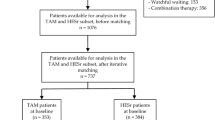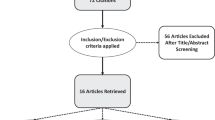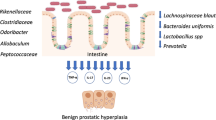Abstract
Recommendations regarding the use of plant-derived medications for the treatment of lower urinary tract symptoms (LUTS) associated with benign prostatic hyperplasia (BPH) state that every brand should be fully evaluated and considered separately. Disparity between a number of brands in terms of their stated and actual doses has been recently highlighted. The aim of this study was to fully quantify the variation in Serenoa repens extracts (SrE) commercially available for the treatment of BPH-associated LUTS. To this end, 14 brands of SrE were compared. Concentrations of free fatty acids (FFAs), methyl and ethyl esters, long-chain esters and glycerides were assessed using liquid and gas chromatography. Many of the brands showed a significantly different proportional content which may have an impact on their clinical efficacy and safety. The high concentrations of FFAs in particular, which previous research has suggested as comprising the active agent of SrE for the treatment of LUTS, may influence the clinical benefit derived from each product. Our findings lend further weight to recommendations by the 5th International Consultation on BPH that plant-derived treatments should be analysed and considered as independent entities despite their common origin. Only extracts with demonstrated pharmacological activities and proven clinical efficacy should be considered for the treatment of patients with BPH.
This is a preview of subscription content, access via your institution
Access options
Subscribe to this journal
Receive 4 print issues and online access
$259.00 per year
only $64.75 per issue
Buy this article
- Purchase on Springer Link
- Instant access to full article PDF
Prices may be subject to local taxes which are calculated during checkout


Similar content being viewed by others
References
Association Européenne des Spécialités Pharmaceutiques Grand Public. (AESPG; 1999) Herbal medicinal products in the European Union. European Commission. http://pharmacos.eudra.org/F2/pharmacos/docs/doc99/Herbal%20Medecines%20EN.pdf.
Lee MR . Plants against malaria, part 2: Artemisia annua (Qinghaosu or the sweet wormwood). J R Coll Physicians Edinb 2002; 32: 300–305.
Chiang LC et al. Cytotoxicity and anti-hepatitis B virus activities of saikosaponins from Bupleurum species. Planta Med 2003; 69: 705–709.
Arias E . United States life tables, 2000. Natl Vital Stat Rep 2002; 51: 1–38.
Gerber GS . Phytotherapy for benign prostatic hyperplasia. Curr Urol Rep 2002; 3: 285–291.
Vallancien G, Pariente P . Treatment of lower urinary tract symptoms suggestive of benign prostatic obstruction in real life practice in France. Prost Cancer Prostatic Dis 2001; 4: 124–131.
Di Silverio F et al. Plant extracts in benign prostatic hyperplasia. Minerva Urol Nefrol 1993; 45: 143–149.
Buck AC . Phytotherapy for the prostate. BJU Int 1996; 78: 325–326.
Bales G, Christiano AP, Kirsh E, Gerber GS . Phytotherapeutic agents in the treatment of lower urinary tract symptoms: a demographic analysis of awareness and use at the University of Chicago. Urology 1999; 54: 86–89.
Gerber G, Kuznetsov D, Johnson BC, Burstein JD . Randomised, double-blind, placebo-controlled trial of saw palmetto in men with lower urinary tract symptoms. Urology 2002; 58: 960–965.
Wilt T, Ishani A, MacDonald R . Serenoa repens for benign prostatic hyperplasia (Cochrane Review). In: The Cochrane Library, Issue 3. Oxford: Update Software, 2002.
Aliaev IG, Vinarov AZ, Lokshin KL, Spivak LG . Five-year experience in treating patients with prostatic hyperplasia patients with permixone (Serenoa repens Pierre Fabre Medicament). Urologiia 2002; Jan–Feb 23–25.
Bayne CW, Donnelly F, Ross M, Habib FK . Serenoa repens (Permixon®): a 5α-reductase types I and II inhibitor-new evidence in a coculture model of BPH. The Prostate 1999; 40: 232–241.
Paubert-Braquet M et al. Effect of the lipido-sterolic extract of Serenoa repens (Permixon®) and its major components on basic fibroblast growth factor-induced proliferation of cultures of human prostate biopsies. Eur Urol 1998; 33: 340–347.
Vacherot F et al. Induction of apoptosis and inhibition of cell proliferation by the lipido-sterolic extract of Serenoa repens (LSESr, Permixon®) in benign prostatic hyperplasia. The Prostate 2000; 45: 259–266.
Mitropoulos D et al. In vivo effect of the lipido-sterolic extract of Serenoa repens (Permixon®) on mast cell accumulation and glandular epithelium trophism in the rat prostate. World J Urol 2002; 19: 457–461.
Weisser H, Tunn S, Behnke B, Krieg M . Effects of the Sabal serrulata extract IDS 89 and its subfractions on 5 alpha-reductase activity in human benign prostatic hyperplasia. The Prostate 1996; 28: 300–306.
Raynaud JP, Cousse H, Martin PM . Inhibition of type 1 and type 2 5alpha-reductase activity by free fatty acids, active ingredients of Permixon. J Steroid Biochem Mol Biol 2002; 82: 233–239.
Paubert-Braquet M, Mencia Huerta J, Cousse H, Braquet P . Effect of the lipidic lipidosterolic extract of Serenoa repens (Permixon®) on the ionophore A23187-stimulated production of leukotriene B4 (LTB4) from human polymorphonuclear neutrophils. Prostaglandins Leukot Essent Fatty Acids 1997; 57: 299–304.
Raso GM et al. Inhibition of inducible nitric oxide synthase and cyclooxygenase-2 expression by flavonoids in macrophage J774A.1. Life Sci 2001; 68: 921–931.
Descotes JL, Rambeaud JJ, Deschaseaux P, Faure G . Placebo-controlled evaluation of the efficacy and tolerability of Permixon® in benign prostatic hyperplasia after exclusion of placebo responders. Clin Drug Invest 1995; 9: 291–297.
Carraro JC et al. Comparison of phytotherapy (Permixon®) with finasteride in the treatment of benign prostatic hyperplasia: a randomized international study of 1,098 patients. The Prostate 1996; 29: 231–240.
Debruyne F et al. Comparison of a phytotherapeutic agent (Permixon) with an α-blocker (tamsulosin) in the treatment of benign prostatic hyperplasia: a 1-year randomized international study. Eur Urol 2002; 41: 497–507.
Boyle P, Robertson C, Lowe F, Roehrborn CG . Meta-analysis of clinical trials of Permixon in the treatment of symptomatic benign prostatic hyperplasia. Urology 2000; 55: 533–539.
Boyle P, Robertson C, Lowe F, Roehrborn CG . Meta-analysis of Permixon in treatment of symptomatic benign prostatic hyperplasia: an update [abstract]. J Urol 2003; 169 (Suppl 4): 1297.
Khoury S et al. International consultation on urological diseases: a decade of progress. The Prostate 2000; 45: 194–199.
Garrard J, Harms S, Eberly LE, Matiak A . Variations in product choices of frequently purchased herbs: caveat emptor. Arch Intern Med 2003; 163: 2290–2295.
Kressman S et al. Influence of pharmaceutical quality on the bioavailability of active components from Gingko biloba preparations. J Pharm Pharmacol 2002; 54: 1507–1514.
Di Silverio F et al. Effects of long-term treatment with Serenoa repens (Permixon®) on the concentrations and regional distribution of androgens and epidermal growth factor in benign prostatic hyperplasia. The Prostate 1998; 37: 77–83.
Bayne CW, Ross M, Donnelly F, Habib FK . The selectivity and specificity of the actions of the lipido-sterolic extract of Serenoa repens (Permixon®) on the prostate. J Urol 2000; 164: 876–881.
Van Coppenolle F et al. Pharmacological effects of the lipido-sterolic extract of Serenoa repens (Permixon®) on rat prostate hyperplasia induced by hyperprolactinemia: comparison with finasteride. The Prostate 2000; 43: 49–58.
Acknowledgements
This paper was sponsored by an unlimited educational grant by Pierre Fabre Médicament.
Author information
Authors and Affiliations
Corresponding author
Rights and permissions
About this article
Cite this article
Habib, F., Wyllie, M. Not all brands are created equal: a comparison of selected components of different brands of Serenoa repens extract. Prostate Cancer Prostatic Dis 7, 195–200 (2004). https://doi.org/10.1038/sj.pcan.4500746
Received:
Accepted:
Published:
Issue Date:
DOI: https://doi.org/10.1038/sj.pcan.4500746
Keywords
This article is cited by
-
Treating LUTS in Men with Benign Prostatic Obstruction: A Review Article
Drugs & Aging (2023)
-
Efficacy and tolerability of the hexanic extract of Serenoa repens compared to tamsulosin in moderate-severe LUTS-BPH patients
Scientific Reports (2021)
-
Use of saw palmetto (Serenoa repens) extract for benign prostatic hyperplasia
Food Science and Biotechnology (2019)
-
S2e-Leitlinie der Deutschen Urologen
Der Urologe (2016)
-
Phytotherapy for Benign Prostatic Hyperplasia
Current Urology Reports (2016)



